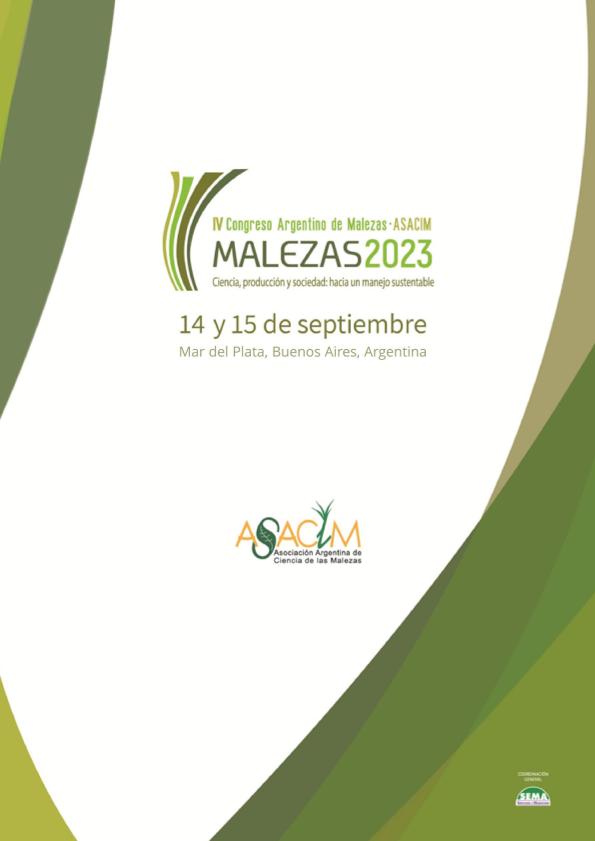Evento
Debido a la resistencia, las malezas mejor adaptadas incrementan su frecuencia en el campo hasta que la población resulta difícilmente controlable con el herbicida utilizado habitualmente. De aquí se desprende la necesidad de implementar estrategias de manejo alternativas donde es crucial el conocimiento de ciertos atributos ecofisiológicos de la especie problema como la germinación esperada bajo ciertas condiciones. El presente ensayo se realizó a fin de evaluar la germinación de poblaciones de Lolium sp. con diversas resistencias a herbicidas bajo un gradiente de condiciones hídricas. Los ensayos se realizaron siguiendo un modelo completamente aleatorizado con cuatro réplicas. Semillas post-maduradas de poblaciones de raigrás susceptible a herbicidas (Pb1), resistente a glifosato (Pb2), resistente a inhibidores de la ALS y de la ACCasa (Pb3) y resistente a glifosato e inhibidores de la ALS y de la ACCasa (Pb4) se embebieron con soluciones de PEG6000 hasta alcanzar un potencial agua de Ψ=0; -0,2; -0,4; -0,8 y - 1,2 Mpa incubándose durante 15 días a 10/20 °C con fotoperíodo de 12 h. Diariamente se contabilizó la germinación calculándose la germinación máxima (Gmax) y la tasa de germinación media (TG50) en función a las semillas viables. Los resultados indican que Pb4 presento menores valores de Gmax (p<0,05) y TG50 a Ψ=0 a -0,4 MPa. A valores menores de potencial agua las cuatro poblaciones presentaron el mismo comportamiento germinativo. Posteriores investigaciones son necesarias para dilucidar si las diferencias en la germinación a potenciales agua mayores se podrían deber a un costo biológico debido a la resistencia múltiple a glifosato e inhibidores de la ALS y de la ACCasa, o podría deberse a algún atributo de la población no vinculado con la resistencia a herbicidas. Due to resistance, better adapted weeds increase their frequency in the field until the population becomes difficult to control with the herbicide usually used. Thus, it is necessary to implement alternative management strategies where the knowledge of certain ecophysiological attributes of the problem species, such as germination under certain conditions. The present trial was conducted to evaluate the germination of Lolium sp. populations with different herbicide resistances under a gradient of water conditions. The trials were conducted following a completely randomized model with four replicates. Post-matured seeds of herbicide susceptible (Pb1), glyphosate resistant (Pb2), ALS and ACCase inhibitor resistant (Pb3) and glyphosate and ALS and ACCase inhibitor resistant (Pb4) populations of ryegrass were embedded with PEG6000 solutions until Ψ=0; -0.2; -0.4; -0.8 and - 1.2 Mpa incubating for 15 days at 10/20 °C with 12 h photoperiod. Germination was estimated daily, calculating the maximum germination (Gmax) and the average germination rate (TG50) based on viable seeds. The results indicate that Pb4 showed lower values of Gmax (p<0.05) and TG50 at Ψ=0 to -0.4 MPa. At lower water potential values all four populations showed the same germination behavior. Further investigations are needed to elucidate whether the differences in germination at higher water potentials could be due to a biological cost as a result of multiple resistance to glyphosate and ALS and ACCase inhibitors, or some population attribute not linked to herbicide resistance.
Germinación de poblaciones de Lolium sp. resistentes a herbicidas bajo un gradiente hídrico
Carreño Salvador, Santiago; Chantre Balacca, Guillermo Ruben ; Sabbatini, Mario Ricardo
; Sabbatini, Mario Ricardo ; Gigón, Ramón; Yanniccari, Marcos Ezequiel
; Gigón, Ramón; Yanniccari, Marcos Ezequiel ; Longás, María de Las Mercedes
; Longás, María de Las Mercedes
 ; Sabbatini, Mario Ricardo
; Sabbatini, Mario Ricardo ; Gigón, Ramón; Yanniccari, Marcos Ezequiel
; Gigón, Ramón; Yanniccari, Marcos Ezequiel ; Longás, María de Las Mercedes
; Longás, María de Las Mercedes
Tipo del evento:
Congreso
Nombre del evento:
IV Congreso Argentino de Malezas
Fecha del evento:
14/09/2023
Institución Organizadora:
Asociación Argentina de Ciencias de las Malezas;
Título del Libro:
IV Congreso Argentino de Malezas
Editorial:
Asociación Argentina de Ciencias de las Malezas
Idioma:
Español
Clasificación temática:
Resumen
Palabras clave:
Maleza
,
Resistencia
,
Raigras
Archivos asociados
Licencia
Identificadores
Colecciones
Eventos(CERZOS)
Eventos de CENTRO REC.NAT.RENOVABLES DE ZONA SEMIARIDA(I)
Eventos de CENTRO REC.NAT.RENOVABLES DE ZONA SEMIARIDA(I)
Citación
Germinación de poblaciones de Lolium sp. resistentes a herbicidas bajo un gradiente hídrico; IV Congreso Argentino de Malezas; Mar del Plata; Argentina; 2023; 132-133
Compartir



